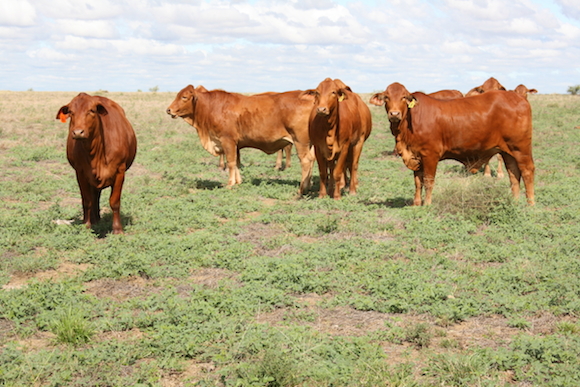The AI Program – How to make it rain
Host: Eversleigh Station
Written by Jenny Underwood – Owner, Eversleigh Station.
The majority of cattle properties throughout northern Australia naturally mate their cows – bulls are put into the paddocks with the females and then nature is allowed to take its course. A lot of cattle operations use controlled mating – the bulls are joined to the females for a prescribed period of time, on average 3-5 months. Controlled mating allows the producer to determine the best time of the year for the females to calve – generally going into the summer months when storms should be on the horizon and green grass should be starting to appear in the paddocks.
On Eversleigh we don’t control mate but rather keep our bulls in all year round. This means that our cows can calve at any time during the year. Due to our seasons being so unpredictable, we have found that in general this suits our operation.
Because we have the two studs besides the commercial cattle, we were encouraged to try out an Artificial Insemination (AI) program which would enable us to access other genetics. So, in 2012, we decided to undertake our first-ever AI program. A good friend, Emma Warne, designed the program for us and came to stay with us for the two weeks during which time she would prepare the heifers for insemination.
 Some of the heifers that were selected for the AI program. They were between 16 and 22 months old. We had had a great start to the year and the heifers were a picture of health.
Some of the heifers that were selected for the AI program. They were between 16 and 22 months old. We had had a great start to the year and the heifers were a picture of health.
We had been told that if you want it to rain, then do an AI program. Sure enough about a week or so before we were going to start, the weather forecasts began to indicate that we were going to have rain around the time that Emma would be here to start the program. However, knowing how unpredictable the forecasts can be we forged ahead with our plans.
Emma arrived in mid-March and her enthusiasm for what she was going to do was infectious. A little bit of rain wasn’t going to stop her! The heifers which she felt would be suitable for the program were drafted up and the 64 “winners” were preg-tested to ensure that they weren’t “miraculously” pregnant (bulls can find sneaky ways of getting into paddocks where they shouldn’t be) and adhesive patches called Kamars were stuck onto their backs near the tail. When a female starts to cycle some of the other females in the mob start “bulling” – trying to ride the heifer. The Kamars have a capsule filled with ink, which under sufficient pressure, bursts indicating that the female is “on heat”.
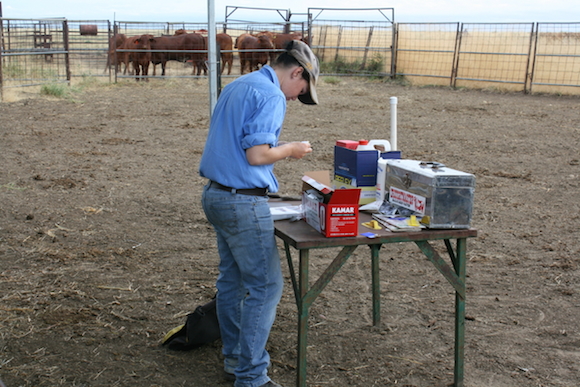 Day one of the program. Emma had already drafted up the heifers and was preparing to preg-test them and then apply the Kamar patches.
Day one of the program. Emma had already drafted up the heifers and was preparing to preg-test them and then apply the Kamar patches.
The heifers were then put out into a holding paddock to be monitored twice a day for the next few days to see whether heifers were bulling and any Kamars were broken.
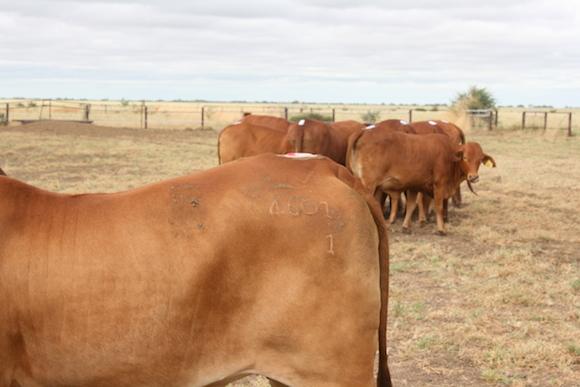 This Kamar has broken and the red ink indicates that the heifer is cycling.
This Kamar has broken and the red ink indicates that the heifer is cycling.
The clouds began to gather and the skies began to look promising.
 Monitoring the heifers. We might as well enjoy smoko while we watch them – in the background the clouds are starting to look promising.
Monitoring the heifers. We might as well enjoy smoko while we watch them – in the background the clouds are starting to look promising.
When a heifer that was cycling was spotted she was quickly walked into the yards, put into the crush and artificially inseminated. Her Kamar was removed and data pertaining to the insemination was carefully recorded – e.g. which bull’s semen was used, the time of day, the ease with which Emma had inseminated her as well as the heifer’s temperament upon insemination.
After a few more days the heifers were artificially brought on to cycle by being given a hormone injection. By this stage the promised rain had also arrived.
Most of our soil type is black soil – there is a saying that “if you stick with the black soil during the dry, it’ll stick with you in the wet”. And that is exactly what happened. The black soil turned to sticky mud overnight. The cattle yards where we were undertaking the program were 7km from the house and they had turned into a quagmire. It was impossible to reach the yards by vehicle so we ploughed over on four-wheeler bikes twice a day to bring the heifers into the yards and inseminate any that were cycling.
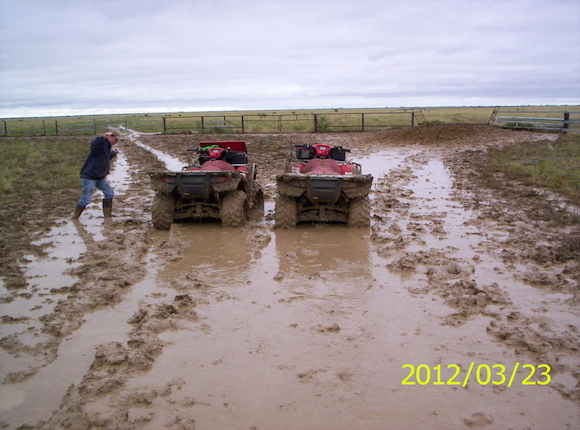 By this stage we had measured over 100mm of rain. Not only getting over to the yards was a challenge but walking the heifers to the yards was proving to be an interesting exercise.
By this stage we had measured over 100mm of rain. Not only getting over to the yards was a challenge but walking the heifers to the yards was proving to be an interesting exercise.
The heifers were incredibly patient and despite the less than optimal conditions amazingly co-operative. Emma had warned us that it was very important when carrying out an AI program that we avoided exposure to the sun, heat, and dust as much as possible. Well we certainly took care of that problem!
 Walking the heifers up the laneway to the yards.
Walking the heifers up the laneway to the yards.
Once a heifer starts to cycle it is important that she is inseminated within the next 6-8 hours. When a bull has it’s semen collected it is put into long narrow straws which hold approximately 0.25mL of semen. The straws are then stored in a special canister and frozen in liquid nitrogen to a temperature of -210 degrees Celsius.
Just prior to being used the straw is then defrosted to exactly 35 degrees Celsius.
 Emma carefully watching the temperature gauge so that once the straw has thawed it can be inseminated as soon as possible into the heifer waiting in the crush.
Emma carefully watching the temperature gauge so that once the straw has thawed it can be inseminated as soon as possible into the heifer waiting in the crush.
The rain did eventually stop but that presented its own problems with the yards being an absolute nightmare. The mud sucked at your boots and threatened to swallow your leg and twist your ankle at each step. How the heifers put up with the twice a day trip into the yards still amazes us.
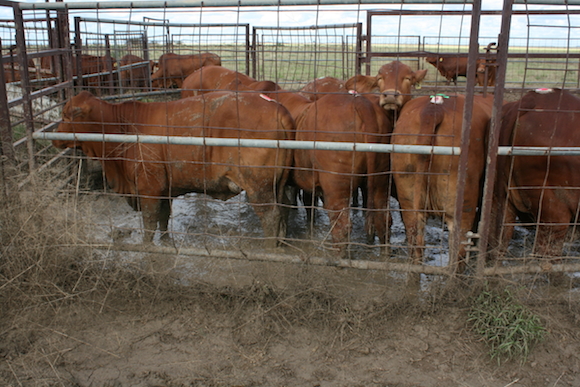 As the hormone drug took effect the number of heifers cycling increased.
As the hormone drug took effect the number of heifers cycling increased.
 The temperament of the heifers was amazing. Despite the yards being a total mess they cooperated brilliantly.
The temperament of the heifers was amazing. Despite the yards being a total mess they cooperated brilliantly.
Emma had never completed an AI program under these conditions before, but to her credit she remained upbeat and cheerful the whole way through.
The whole program lasted two weeks. Towards the end of Emma’s stay the sun once again returned making the completion of the AI program a lot easier.
The heifers which had cycled and had been inseminated were returned to their paddock. I am sure that they all breathed a huge sigh of relief to see their familiar surroundings after the trials and tribulations of the previous fortnight.
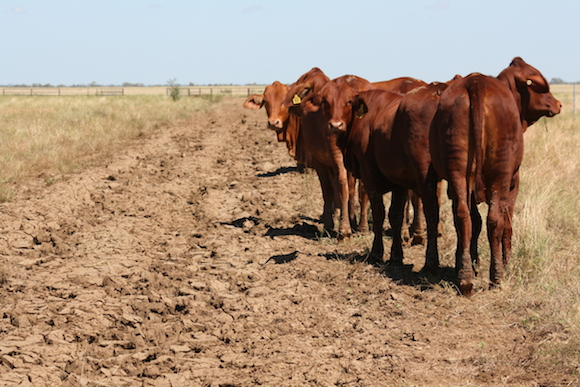
After a period of about 3-4 months the 64 heifers were brought back in to be preg-tested to ascertain how many had been successfully impregnated. Remarkably we had a PTIC rate of 55% which under the extreme circumstances was outstanding.
Now we just had to wait until the end of the year when the heifers would start to calve. Little did we realise it but we had more challenges ahead of us!
